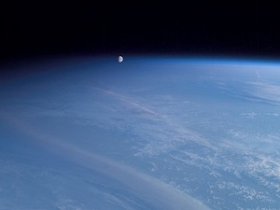Global changes in the atmosphere
 Water vapour in the upper troposphere, the lowest layer of the atmosphere, ‘strongly regulates the strength of water-vapour feedback’ Photograph: NASA/AFP/GETTYIMAGES
Water vapour in the upper troposphere, the lowest layer of the atmosphere, ‘strongly regulates the strength of water-vapour feedback’ Photograph: NASA/AFP/GETTYIMAGES
We have long suspected that greenhouse gases which cause the Earth to warm would lead to a wetter atmosphere. The latest research published by Eul-Seok Chung, Brian Soden, and colleagues provides new insight into what was thought to be an old problem. In doing so, they experimentally verified what climate models have been predicting. The models got it right… again.
To be clear, this paper does not prove that water vapor is a greenhouse gas. We have known that for years. Nevertheless, the paper make a very nice contribution. The authors show that the long-term increase in water vapor in the upper troposphere cannot have resulted from natural causes – it is clearly human caused. This conclusion is stated in the abstract,
Our analysis demonstrates that the upper-tropospheric moistening observed over the period 1979–2005 cannot be explained by natural causes and results principally from an anthropogenic warming of the climate. By attributing the observed increase directly to human activities, this study verifies the presence of the largest known feedback mechanism for amplifying anthropogenic climate change.
As stated earlier, climate models have predicted this moistening – before observations were available. In fact, the models predicted that the upper troposphere would moisten more than the lower atmospheric layers. As the authors state,
Given the importance of upper-tropospheric water vapor, a direct verification of its feedback is critical to establishing the credibility of model projections of anthropogenic climate change.
To complete the experiments, the authors used satellite measurements of radiant heat. The emissions have changed but it wasn’t clear why they have changed. Changes could be caused by increases in temperature or from increased water vapor. To separate the potential effects, the authors compared the first set of experiments with others made at a different wavelength. That comparison provided a direct measure of the separate effect of moistening.
Next, the authors used the world’s best climate models to test whether the observed trends could be caused by natural changes in the Earth’s climate or whether they require a human influence. Sure enough, only the calculations that included human-emitted greenhouse gases matched the observations. The authors conclude that,
Concerning the satellite-derived moistening trend in recent decades, the relations of trend and associated range among three experiments lead to the conclusion that an increase in anthropogenic greenhouse gases is the main cause of increased moistening in the upper troposphere.
The authors then went further by showing that their computed results encompass third-party measurements only when the impacts of human-emitted greenhouse gases are included.

